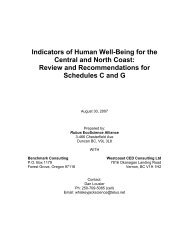Final report - Integrated Land Management Bureau
Final report - Integrated Land Management Bureau
Final report - Integrated Land Management Bureau
Create successful ePaper yourself
Turn your PDF publications into a flip-book with our unique Google optimized e-Paper software.
Transportation Assessment of the Central & North Coast of BC<br />
that one is now contemplating the opportunity of a new scheduled run from<br />
Campbell River to Prince Rupert in 2009 assuming the market proves to be a<br />
productive venture.<br />
Reducing the number of empty backhauls, increasing barge frequency to<br />
communities, and lowering barge service cost will require BC Government<br />
leadership because of the multiplicity of players and interests embedded in this<br />
issue. This issue is not in need of a government solution and is not a matter of<br />
imposing a new arrangement but of leading a collaborative process that<br />
improves services and reduces costs. The issue is a marine “trucking” problem<br />
and will have to be solved by marine freight transport providers and their many<br />
customers but the lack of one or two major players means a BC Government<br />
facilitation and leadership role would be helpful.<br />
► Issue: The Canadian Marine Act puts Prince Rupert at a financial<br />
disadvantage compared to US ports<br />
In the early years of 2000, the Port of Prince Rupert was focused on a few<br />
commodities, grain, coal and pulp, and throughput volumes of each were<br />
declining. The SCI pulp mill closed in June 2001 and its new owners, first New<br />
Skeena Forest Products and then Sun Wave, were unable to get it re-financed<br />
and operational. The last Tumbler Ridge coal mine, Bullmoose, closed in 2003.<br />
In the wake of these difficult economic events, Port of Prince Rupert<br />
leadership, in collaboration with CN Rail, BC Government and other partners,<br />
embarked on diversifying its services and customers by planning and organizing<br />
the financing for large cruise ship and container terminals and obtaining a<br />
major operator for the new container terminal. With the openings of the new<br />
cruise ship terminal for the 2004 Alaska cruise season and Phase I of the<br />
Fairview Terminal in October 2007, many new economic opportunities became<br />
available for Prince Rupert area residents and BC communities along the CN<br />
Rail line. New or expanded tourism excursions have started, and there is<br />
greatly heightened awareness of the importance and potential of tourism as an<br />
economic generator. New port jobs have been created in container movement,<br />
customs, security, and logistics. A new inter-modal facility was built at Prince<br />
George, and port management continues to make arrangements to expand port<br />
facilities, such as the Canpotex potash terminal project.<br />
There have been some recent setbacks in the port’s expansion. Westpac moved<br />
the proposed location of its LNG project to Texada Island in the Strait of<br />
Georgia in early 2007 60 and the current worldwide economic difficulties has led<br />
to a delay in going forward with the Phase II expansion of the container<br />
60 Calgary headquartered Westpac LNG entered into a Memorandum of Understanding with the Prince Rupert<br />
Port Authority for a 30-year lease in mid 2006 for a liquified natural gas terminal on Ridley Island but<br />
cancelled the project in early 2007 and announced that it instead planned to build a LNG terminal and<br />
associated gas-fired electricity generating plant on Texada Island in the Strait of Georgia.<br />
Chisholm Consulting 81

















